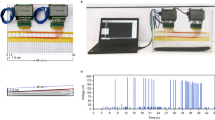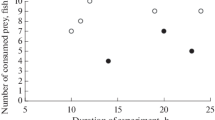Summary
We have examined how the electric organ discharge (EOD) of a mormyrid (Gnathonemus petersii) is affected by changes in resistive load (Figs. 3, 4, 5). We have also shown how this load depends on resistivity and distance to non-conducting boundaries (Figs. 10, 11). When resistive load was varied, voltage and current were related in a linear, battery-like manner for the initial, head positive phase of the EOD (Figs. 4, 5). This linear relation made it possible to estimate first phase e.m.f. and source resistance. For the second, head negative phase, however, voltage rose to a peak and then fell as resistance increased. Furthermore, the waveform of the second but not the first phase was strongly affected by load changes. These second phase features were shown to reflect a dependence of second phase e.m.f. on first phase current. A linear and battery-like relation between second phase voltage and current was seen when first phase load was held constant while varying second phase load (Fig. 6). These results on the behavior of the whole electric organ can be understood in terms of the underlying properties of the cellular generators, the electrocytes.
Similar content being viewed by others
References
Altamirano, M., Coates, C.W., Grundfest, H.: Mechanisms of direct and neural excitability in electroplaques of electric eel. J. gen. Physiol.38, 319–360 (1955)
Aubert, X., Keynes, R.D.: The temperature changes during and after the discharge of the electric organ inElectrophorus electricus. Proc. roy. Soc. B169, 241–263 (1968)
Belbenoit, P.: Determination de la distance maximale d'électro-réception des objets chex les Mormyrides. J. Physiol. (Paris)62, (Suppl. 3) 344 (1970)
Bennett, M.V.L.: Comparative Physiology: Electric organs. Ann. Rev. Physiol.32, 471–528 (1970)
Bennett, M.V.L.: Electric organs. In: Fish physiology, Vol. V, pp. 347–491 (Hoar, W.S., Randall, D.J., eds.). New York and London: Academic Press 1971
Bennett, M.V.L.: Electroreception. In: Fish physiology, Vol. V, pp. 493–574 (Hoar, W.S., Randall, D.J., eds.). New York and London: Academic Press 1971
Bennett, M.V.L., Grundfest, H.: Studies on the morphology and electrophysiology of electric organs. III. Electrophysiology of electric organs in Mormyrids. In: Bioelectrogenesis, pp. 113–135 (Chagas, C., Paes de Carvalho, A., eds.). Amsterdam: Elsevier 1961
Bruns, V.: Elektrisches Organ vonGnathonemus petersii (Mormyridae). Z. Zellforsch.122, 538–561 (1971)
Cox, R.T., Coates, C.W., Brown, M.V.: Relations between the structure, electrical characteristics and chemical processes of electric tissue. J. gen. Physiol.28, 187–212 (1945)
Frankenhaeuser, B., Huxley, A.F.: The action potential in the myelinated nerve fibre ofXenopus laevis as computed on the basis of voltage clamp data. J. Physiol. (Lond.)171, 302–315 (1964)
Frey, A.H., Eichert, E.S.: The nature of electrosensing in the fish. Biophys. J.12, 1326–1358 (1972)
Gosse, J.P.: Le milieu aquatique et l'écologie des poissons dans la région de Yangambi. Ann. Mus. Afr. Centr. Tervuren, ser in −8°. Zoologiques116, 113–249 (1963)
Harder, W.: Nachweis aktiver (elektrischer) Ortung bei Mormyridae (Teleostei, Pisces). Z. Tierpsychol.30, 94–102 (1972)
Harder, W., Schief, A., Uhlemann, H.: Zur Funktion des elektrischen Organs vonGnathonemus petersii (Gthr, 1862) (Mormyriformes, Teleostei). Z. vergl. Physiol.48, 302–331 (1964)
Keynes, R.D.: The temperature changes during and after the discharge of the electric organ inMalapterurus electricus. Proc. roy. Soc. B169, 265–274 (1968)
Knudsen, E.I.: Spatial aspects of the electric fields generated by weakly electric fish. J. comp. Physiol.99, 103–118 (1975)
Scheich, H., Bullock, T.H., Hamstra, R.H.: Coding properties of two classes of afferent nerve fibers: High frequency electroreceptors in the electric fish. J. Neurophysiol.36, 39–60 (1973)
Schwartz, I.R., Pappas, G.D., Bennett, M.V.L.: The fine structure of electrocytes in weakly electric teleosts. J. Neurocytol.4, 87–114 (1975)
Szabo, T.: Les organes electriques des Mormyrides. In: Bioelectrogenesis, pp. 20–23 (Chagas, C., Paes de Carvahlo, A., eds.). Amsterdam: Elsevier 1961
Szabo, T., Fessard, A.: Physiology of electroreceptors. In: Handbook of sensory physiology, Vol. III, Part 3: Electrorecepoors and other specialized receptors in lower vertebrates (Fessard, A., ed.). Berlin-Heidelberg-New York: Springer 1974
Szabo, T., Hagiwara, S.: A latency change mechanism involved in sensory coding of electric fish. (Mormyrids). Physiol. Behav.2, 331–335 (1967)
Waltman, B.: Electrical properties and fine structures of the ampullary canals of Lorenzini. Acta physiol. scand.66, (Suppl. 264), 1–60 (1966)
Author information
Authors and Affiliations
Additional information
We wish to express appreciation to Drs. Neal Barmack and Curtis Boylls for their helpful discussions during this work and to Dr. M.V.L. Bennett for his critical reading of the manuscript. We also thank Mrs. Jacqueline Bolen for her preparation of the manuscript. Funds for the work were provided by NIH (NINDS-06728) and NSF (GB37836).
Rights and permissions
About this article
Cite this article
Bell, C.C., Bradbury, J. & Russell, C.J. The electric organ of a mormyrid as a current and voltage source. J. Comp. Physiol. 110, 65–88 (1976). https://doi.org/10.1007/BF00656782
Received:
Issue Date:
DOI: https://doi.org/10.1007/BF00656782




